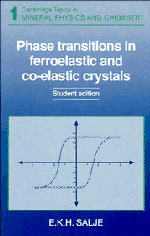Book contents
- Frontmatter
- Contents
- Errata
- Preface
- A brief guide for the reader
- 1 Introduction and some definitions
- 2 Ferroelastic and co-elastic phase transition
- 3 The Landau potential
- 4 The spontaneous strain
- 5 Coupling between the spontaneous strain and the order parameter
- 6 Macroscopic classification of ferroic and co-elastic crystals
- 7 Ferroelastic and co-elastic twin structures
- 8 Domain mobilities and elastic instabilities in ferroelastic and co-elastic materials
- 9 Specific heat anomalies and the excess entropy
- 10 Coupling between order parameters in ferroelastic and co-elastic crystals
- 11 Gradient coupling and strain modulations
- 12 Some aspects of the kinetic behaviour of ferroelastic and co-elastic crystals: an outlook
- References
- Appendix: An atomistic model for the Landau potential and the origins of the saturation effect
- Index
5 - Coupling between the spontaneous strain and the order parameter
Published online by Cambridge University Press: 03 May 2011
- Frontmatter
- Contents
- Errata
- Preface
- A brief guide for the reader
- 1 Introduction and some definitions
- 2 Ferroelastic and co-elastic phase transition
- 3 The Landau potential
- 4 The spontaneous strain
- 5 Coupling between the spontaneous strain and the order parameter
- 6 Macroscopic classification of ferroic and co-elastic crystals
- 7 Ferroelastic and co-elastic twin structures
- 8 Domain mobilities and elastic instabilities in ferroelastic and co-elastic materials
- 9 Specific heat anomalies and the excess entropy
- 10 Coupling between order parameters in ferroelastic and co-elastic crystals
- 11 Gradient coupling and strain modulations
- 12 Some aspects of the kinetic behaviour of ferroelastic and co-elastic crystals: an outlook
- References
- Appendix: An atomistic model for the Landau potential and the origins of the saturation effect
- Index
Summary
Here we reconcile the thermodynamic quantity ‘order parameter’ and the geometrical quantity ‘spontaneous strain’. Their temperature dependencies may follow each other but do not necessarily do so. Some symmetry arguments help to identify possible non-linearities. The coupling between the order parameter and the spontaneous strain produces an important physical effect: elastic softening of the crystal. Some simple algebra is needed to quantify the behaviour of the elastic constants. The reader is encouraged to work through this chapter because it illustrates some arguments which will be used repeatedly later on.
So far we have introduced the order parameter as the thermodynamic quantity which describes the phase transition and the macroscopic spontaneous strain as a convenient physical parameter which serves to characterise the change of shape of a crystal (or of the crystallographic unit cell for the structural or spontaneous strain). In some crystals, the order parameter and the spontaneous strain are simply proportional to each other. In most crystals this is not the case, however, and we must now explore rather carefully the possible correlations between the thermodynamic order parameter, Q, and the structural spontaneous strain, es. The general scope of this treatment is the coupling theory (e.g. Salje and Devarajan 1986, Achiam and Imry 1975, Gufan and Larin 1980, Imry 1975, Oleksy and Prysztawa 1983). It is based on the assumption that the crystal is in thermodynamic equilibrium with a surrounding heat bath and that its structural state is dictated by the condition that no structural variables can be changed without loss of energy.
- Type
- Chapter
- Information
- Publisher: Cambridge University PressPrint publication year: 1991



